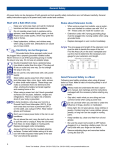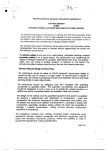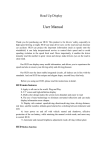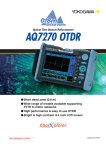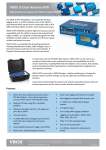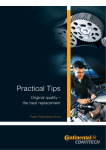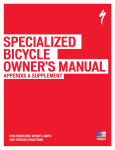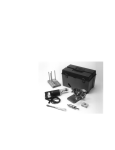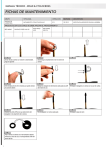Download Clincher Wheel User Manual
Transcript
Congratulations on your purchase of Williams wheels. To ensure the best performance and longest service life from your wheels please read and carefully follow these instructions. CAUTION! Bicycle wheels, like most bicycle components, require special knowledge, skills, and tools for correct installation and maintenance. All Williams products should be installed and serviced by a qualified bicycle mechanic using appropriate professional tools. Williams assumes no liability for products that are improperly installed or maintained. WARNING! Failure to follow these instructions can result in component failure. Component failure can lead to loss of control of the bicycle and result in serious personal injury or death. These instructions are for Williams road wheels requiring rim strips. 1. Before you start To get the maximum performance, reliability and enjoyment from your Williams wheels there are a few things you need to know, understand and do. Please do not skip reading this entire section. What you miss could result in mechanical malfunction or component failure. • Williams wheels should only be used with forks that have secondary wheel retention safety tabs on the dropouts to prevent accidental loss of the wheel. Loss of a wheel can result in serious injury or death. • Always use Williams wheel quick releases, and always follow the Williams Quick Release instructions which are in this instruction manual. Riding with an improperly adjusted wheel quick release can allow the wheel to wobble or fall off the bicycle, which can cause serious injury or death. • Williams makes different wheel models for different specific purposes: Road, Cyclocross, etc. Subjecting the wheels to uses for which they were not designed can result in component failure. • The Williams Quick Releases must be used to correctly to prevent the wheel from disengaging from the bicycle. Read and understand the Williams Quick Release instructions before using the wheels. If unsure about Williams Quick Release operation, please consult with and authorized professional bike shop for proper operation and instruction. • Attach wheel reflectors (available separately) to your wheels for safety during periods of poor visibility. 2. Mounting a Tire a. Preparation • Wear safety glasses when mounting and pressurizing tires. Serious injury can result if the tire comes off the rim during or after inflation. • Use on plastic tire levers for mounting a tire. Using metal levers or a screwdriver can damage the rim and cause tire or tube failure. • All Williams rims are drilled at the factory for presta valve tubes. Drilling a rim for a larger valve hole can cause component failure and voids the warranty. b. Tube and Tire Mounting Procedure. • Mount the rim strip, making sure that it covers all spoke holes in the rim bed. Exposed spoke holes can cause the tube to fail, resulting in loss of control. • Confirm the tire is oriented for proper rotation direction, then mount one tire bead onto the rim. • Insert the tube valve into the valve hole and place the tube evenly within the tire casing. Confirm that the tube is not folded or twisted. • Mount the second tire bead onto the rim. Use tire levers only as necessary. • Pump the tire to a low pressure. Confirm that both tire beads are evenly seated in the rim bead. • Pump the tire to full pressure, as recommended by the tire manufacturer. • Reconfirm that both tire beads are evenly seated in the rim bead. If either tire bead is not seated evenly, remove pressure, adjust the tire on the rim and re-pressurize. Riding a bicycle with an incorrectly seated tire bead can result in component failure. 3. Mounting a Cassette • Lightly grease the outside of the cassette body splines before mounting cassette. • Lightly grease the lock ring threads and torque the lock ring into place to 30-50 Nm (260-435 in-lbs). • NOTE: In use, the smallest 2 or 3 cogs typically create small dents in the splines of the alloy cassette body. This is normal, and not a sign of excess loads or incorrect installation. 4. Before Your Ride • Before each ride, check that both wheel quick releases are securely fastened. Riding with an improperly adjusted wheel quick release can allow the wheel to wobble or fall off the bicycle, which can result in serious injury or death. • Before each ride, check rims and hubs of both wheels for dents, scratches or cracks; check wheels for trueness; and make sure that both wheels are true, with no loose or bent spokes. A damaged wheel can result in component failure. • Keep body parts and loose clothing away from spinning wheels and brake rotors during use and servicing to avoid the risk of severe cuts. • Make sure tire pressures are correct, and carefully inspect the tires before each ride. Replace the tire or tube before riding if either is worn or damaged. Incorrect tire pressure, excess tire wear, or cuts or damage to the tread, sidewall, casing or inner tube can cause component failure. • When riding, avoid rim damage from impact on the road or trail by using correct tire pressure (see chart below) and paying attention while riding. Serious rim damage could result in the tire coming off the rim, or in tire failure. Damaged rims must be replaced to prevent component failure. Road Wheels: 100-125psi Cyclocross Wheels: 35-85 psi • Patch an inner tube only in an emergency, and replace it before your next ride. An inner tube does not retain its strength and integrity once it has been patched, and could fail, resulting in loss of control and serious injury or death. 5. Maintenance • Wheel truing, spoke tensioning, hub and cassette body maintenance, like many other bicycle maintenance and repair procedures, require skill, experience and special tools. If you insist on performing some or all of these procedures yourself we urge you to have a professional bicycle mechanic check your work before you ride the bike. Errors in maintenance, service and repair procedures can result in component failure and will void the warranty. • Frequency of maintenance is a function of riding style, mileage and environment. • Do not wash hubs using a high-pressure washer or special solvents. Grease could be washed from the hub and/or cassette body bearings, which could result in component failure. • If there are signs of loose spokes or excessive rim runout after 250mi (400km), wheels should be retensioned and trued by a professional bicycle mechanic. This service is not covered by warranty, so you may be charged for it. Riding with wheels that are out of true can result in loss of braking, loss of control or component failure. • Rear wheels are subjected to higher loads and stress than front wheels and may require more frequent tension and true adjustment. • Periodically inspect the rim, spoke holes, and seam for dents, damage and cracks. On rim brake rims, periodically clean rim brake surfaces with alcohol for best performance. • Excessive wear on brake surfaces can result in rim failure and loss of control. Replace rims if you see excessive brake surface wear. • To maintain maximum rim brake effectiveness and prevent possible rim damage, replace brake pads when worn. Riding with work brake pads can result in loss of braking, loss of control or component failure. • Use only genuine Williams replacement parts. Use of non-Williams parts could result in damage or component failure, and will void the warranty. WARRANTY Williams wheels are warrantied to be free of defects in materials and workmanship for one (1) year from the date of purchase. Warranty is for the original owner only and proof of purchase is required. This warranty is in lieu of all other warranties. ANY IMPLIED WARRANTIES OF FITNESS FOR A PARTICULAR PURPOSE OR WARRANTIES OF MERCHANTABILITY ARE LIMITED TO THE DURATION OF THE EXPRESSED WARRANTY. Depending on individual state laws, the above exclusion may not apply to you. This warranty gives you specific rights. You may have other legal rights depending on the state in which you reside. Please consult the Contact Us page of the Williams website www.williamscycling.com for warranty contact information. Quick Release Williams quick release levers should only be used with forks that have secondary wheel retention safety tabs on the dropouts to prevent accidental loss of wheel. WARNING! Riding with an improperly adjusted wheel quick release can allow the wheel to wobble or fall off the bicycle, which can cause serious injury or death. Therefore, it is essential that you: • Make sure you know how to install and remove your wheels safely. • Understand and apply the correct technique for clamping your wheel in place with a quick release. • Each time, before you ride the bike, check that the wheels are securely clamped. TO INSTALL A WHEEL • If a bike has rim brakes, disengage brake quick-release. • Insert wheels into fork or rear dropouts with lever in positions. • Swing lever to horizontal (ADJUST) position, making sure lever cam is correctly seated in cam guide washer; then, holding lever in ADJUST position with one hand, tighten (turn clockwise) tension adjusting nut with other hand until Quick Release clamping surfaces are finger tight against dropouts. • Make sure wheels is fully seated in dropouts and centered; then swing lever into position (CLOSED), at right angle to hub axle and either behind or in front of fork blade (front wheel) or chain or seat stay (rear wheel) for leverage, and lever should leave a clear imprint on your palm. WARNING! If you can fully close the quick release without wrapping your fingers around the fork blade or frame tube for leverage, and lever does not leave a clear imprint in the palm of your hand, the tension is insufficient. Open the lever; turn tension adjusting nut clockwise a quarter turn; then try again. If you cannot swing lever all the way to its Detent Stop when moving it to position, open it to position, turn nut counter-clockwise a quarter turn; then try again. • If bike has rim brakes, close brake quick release. • Make sure brakes are operating correctly. TO REMOVE A WHEEL • If bike has rim brakes, disengage brake quick release. • Swing lever from position: (CLOSED) to position: (OPEN); then turn Tension Adjusting Nut counterclockwise, if needed, until wheel can come out of dropouts. You may have to tap the top of the wheel with the palm of your hand to knock the wheel out of dropouts. ALWAYS: Be sure to correctly re-tension quick release mechanism every time you re-install a wheel. Each time you get ready to ride any bike, check wheel quick releases to make sure they are securely clamped. LUBRICATION: Periodically clean and lubricate lever’s cam surface and cam guide washer, cam pivot and skewer threads.



